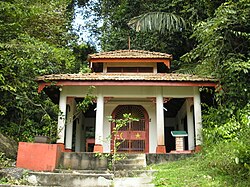Malaysian folk religion refers to the animistic and polytheistic beliefs and practices that are still held by many in the Islamic-majority country of Malaysia. Malaysian folk faith is practiced either openly or covertly depending on the type of rituals performed. Some forms of belief are not recognised by the government as a religion for statistical purposes although such practices are not outlawed. There is a deep interaction between the Chinese folk religion of the large Malaysian Chinese population, and the indigenous Malaysian folk religion.
Overview

There are different types of Malaysian folk religion practised throughout the country. Shamanic performances are held by people known as dukuns, otherwise also known as dukun or pawang. Most Orang Aslis (indigenous people) are religiously animist and believe in spirits residing in certain objects. However, some have recently converted to mainstream religions due to state-sponsored Islamic da'wah or evangelised by Christian missionaries.
In Indonesia indigenous religions are also practised by various Borneo tribal groups. The Chinese generally practice their folk religion which is also animistic in nature. The word "bomoh" has been used throughout the country to describe any person with knowledge or power to perform certain spiritual rituals including traditional healing, and as a substitute for the word "shaman". Generally speaking, Indonesians have deep superstitious belief, especially more so in the rural areas.
History
_Sukhothai_Tao_Kong_Pa.jpg/150px-201401011008b_(Hartmann_Linge)_Sukhothai_Tao_Kong_Pa.jpg)
Historically, before the arrival and spread of Islam in the 15th century, and the spread of Christianity from the 19th century, the inhabitants in the land were either Hindus or practiced indigenous faiths. In the peninsula, widespread Islamification is said to have begun in 1409 after Parameswara became Sultan of Malacca and converted into Islam after marrying a princess from Pasai. Since then, other Sultanates in the Malay peninsula have adopted Islam. Also since then, and continuing after the independence of Malaysia, Islam played a central role in Malaysian society.
Similarly in East Malaysia, folk religion was widespread prior to the arrival of Christian missionaries from Europe. The practice of headhunting was quite common in these societies. In Sabah, the Kadazan-dusuns would worship Kinoingan or rice spirit and celebrate Kaamatan or harvest festival every year. During Kaamatan, there are certain rituals which has to be carried out by the high-priestesses known as the bobohizans. Today, most Kadazandusuns have adopted Christianity but some would still celebrate Kaamatan. However, the number of bobohizans has tremendously dropped and is in the brink of extinction. In Sarawak, it has been said that the animism practised by the Ibans (Satsana Phi) and other related groups is the most developed, elaborated, and intellectualised in the world. Folk religious practice in East Malaysia is related to the religion of Kaharingan in Kalimantan, Indonesia, which has been recognised as an official religion by the Indonesian government. However, the rituals involved are not entirely similar with variations depending on the ethnic subgroups which practices it.
Shamanism and traditional healing

The shamans bomohs or witch doctors still practice their craft in Malaysia. The bomoh practice by Malays have been integrated into Islam and is not forbidden. They are also known as traditional healers and sometimes serve as an alternative to conventional modern medicine. However, the practice has sometimes been viewed negatively by Malaysian society as in some instances bomohs have the power to cast spells (jampi) and have used them on other people with ill effects. The number practitioners of bomohs has also dropped.
The bobohizans of Sabah are also shamans and are traditional healers. They also act as a medium to communicate with spirits and play an important role in the rituals involved during Kaamatan.
Recently there has been suggestions for the need and importance to preserve the practice of bomohs and other shamans as traditional healers and to complement or substitute conventional modern medicine.
Chinese folk religion

Today most of the Chinese population in Malaysia are Buddhists, while the rest are Confucianists, Taoists, Christians, and a small number of Muslims and Hindus. Most Chinese still adhere to the Chinese traditional religion (Shenism) or ancestor worship in tandem with their (mainstream) religion. However, some have stopped practising this religion after adopting a mainstream religion which prohibits animism or idolatry. As is the case in China, the practice of this religion is not documented by the government for statistics purpose. Thus the number of followers in Malaysia can only be estimated.
See also

- Burmese folk religion
- Chinese folk religion
- Vietnamese folk religion
- Satsana Phi
References

